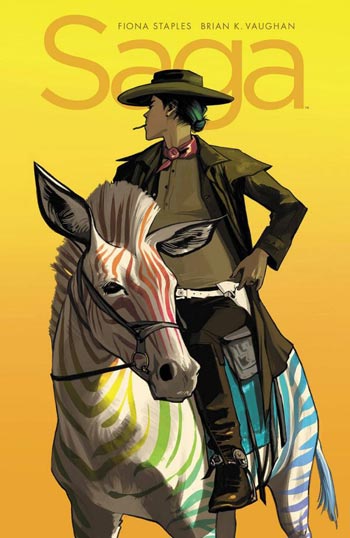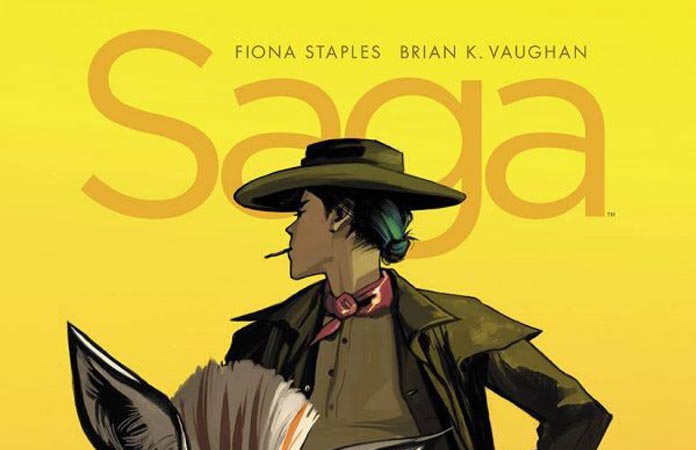Comics Review: Saga
Published on June 30th, 2017 in: Comic Reviews, Comics, Current Faves, Magick, Reviews, Science and Technology, Science Fiction |By E.A. Henson
With these review pieces I normally try and tackle something new and worthy of your attention. For this piece in particular I’ll be taking a look at something that’s not terribly new but still is something of note, Saga by Brian K. Vaughan and Fiona Staples.
First published in 2012, Saga is a mash-up of the Fantasy and Speculative Fiction genres. I’ll stay away from the “it’s blank meets blank” descriptions that currently rule the land and let you drop in your own favorite franchises. In brief, Saga is a space epic with nudity and swears… Like Star Wars meets Game of Thrones. Dammit.
When trying to describe this book I’ll admit to feeling a bit like the Stefon character from Saturday Night Live. “This book has everything: robots with TV faces, tiny baby seal people, forbidden love, a dragon fellating itself…” There’s definitely a kitchen-sink approach to world building with this book and it all totally works.
The level of collaboration between Staples and Vaughan is seamless. I’d like to imagine that when Staples gets one of Vaughan’s scripts to illustrate the character descriptions are something along the lines of “I dunno. Just draw whatever LOL!” The design work by Staples is second to none and you’ll never see the same alien or creature twice unless plot dictates it.
From a story standpoint Saga is set against the backdrop of interplanetary war between two societies. One magical and one technological, and that’s about all you need to know. Spells and monsters exist along lasers and space ships. It’s all real and it all takes a backseat to the main story about a husband and wife trying to raise their daughter during the war.
Characters Alana and Marko are from opposing sides of the conflict, so of course they meet, fall in love, and have a child, and that’s what kicks off the book. The trope of FORBIDDEN LOVE may be the most troped trope of all time but everything has to start somewhere and Saga doesn’t linger on it. It’s addressed from time to time as a reminder for the reader but the plot isn’t hung up on it.
The book is narrated by their daughter Hazel, who is born in the first issue, and is presumably telling the story as an adult. The narration works well in the book as it serves to open and close the issues, it offers only the vaguest hints of what’s to come. Unless Vaughan pulls an American History X and reveals at the end of the book “SHE’S BEEN DEAD THE WHOLE TIME” I can’t imagine myself getting bored with this narrative device.
So, you’ve got your love story and your space epic, what else do you need? As much as it pains me to write the words “hot button topics” I’m going to do it anyway. You’ve got your hot button topics and Saga, to date, has shied away from exactly none of them.
Mainstream Science Fiction has, in the past, been pretty on-the-nose with addressing topics. I love Star Trek but have always found its handling of certain issues lacking. For homework you can go watch an episode of Star Trek: The Next Generation titled “The Outcast” (Season 5, Episode 17). It’s an episode that bravely asks, “How can Riker bang an alien that has no gender?” Well, Riker finds a way. Riker always finds a way. It’s a clumsy episode that just kind of happens and is never referenced again. Also Trek hasn’t had a prominent LGBTQ character in its 50-year history.
With Saga you’re getting precisely none of what I outlined above and it’s refreshing. I’m not saying that the universe the characters exist in is some kind of utopia for all genders, creeds, and sexualities. Far from it. But everything, everyone, exists in Saga. Like any good piece of veiled social commentary it holds the mirror up to the audience and we may not be comfortable with what we see.
If you’re looking to get into the world of Saga, issue #43 began a new story arc and was made available for only twenty-five cents. The issue is a good jumping on point for new readers since it includes a brief summation of the previous 42 issues all without distracting the narrative flow if the issues. Saga traditionally runs in six-issue arcs then takes a few months off before collecting the preceding arc in a trade paperback. So, if you read the arc and love it you can spend the hiatus getting caught up on what has gone on before. Like that dragon I mentioned up top.


Time limit is exhausted. Please reload the CAPTCHA.